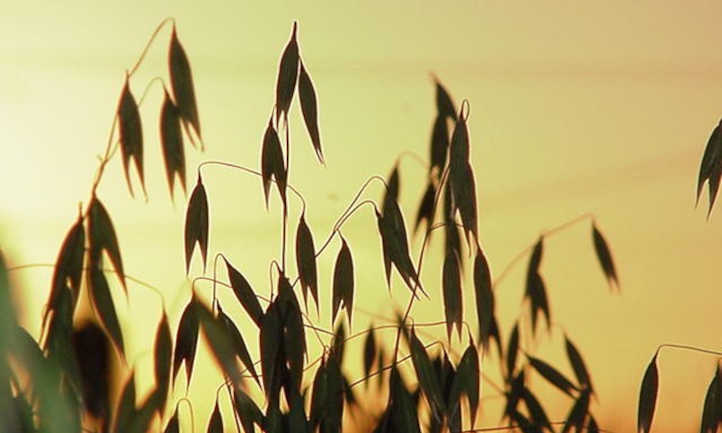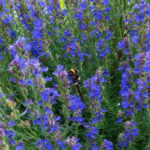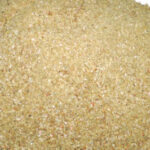Whether you’re growing them for flour or to make a simple porridge, oats are a staple crop for many. Avena sativa is the botanical name of this grassy crop, and it’s one that most expect to see in huge, commercially-farmed fields. But growing oats can be done at home as well, and in fact, it makes for an effective cover crop when sown in the fall months. But if grown during its normal growing season, you’ll get lovely oat seed heads when the time is right!
The common oat is widely grown around the world. Genetic evidence shows that oats were first cultivated in the Fertile Crescent region of the Near East before spreading westward into the more temperate regions of Europe and the Middle East.
Other than being a healthy grain, they have several uses in the garden. Their stalks make great straw, young plants can be tilled under to produce green manure, and the tight plantings help protect the soil. Oats are incredibly disease-resistant and fun to grow!
Quick Care Guide
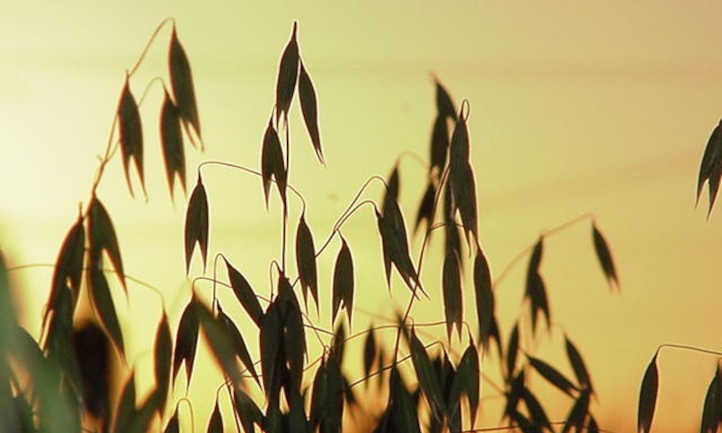
| Common Name(s) | Oat, common oats |
| Scientific Name | Avena sativa |
| Days to Harvest | 100-120 days |
| Light | Full to partial sun |
| Water | 1 inch per week |
| Soil | Fertile, well-drained soil |
| Fertilizer | Optional, nitrogen helps speed growth |
| Pests | Aphids, armyworms, wireworms, birds |
| Diseases | Anthracnose, crown rust, powdery mildew, loose smut, barley yellow dwarf, scab |
All About Oats
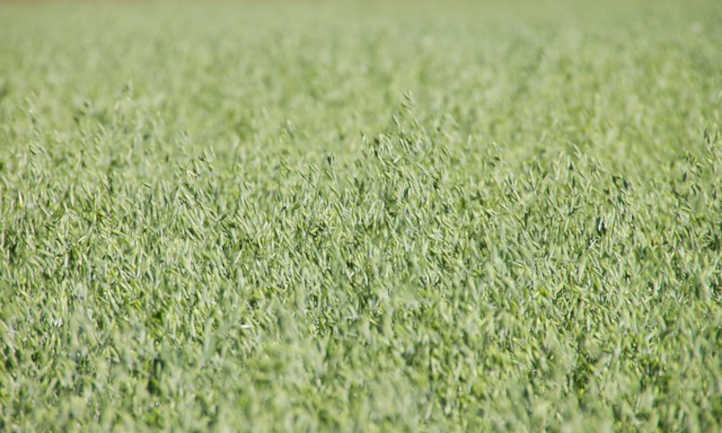
Oats are categorized as cereal crops, which means they’re a type of grass that is grown specifically for its seed. Like other grains, the plant features a tall stalk with thin, pointed leaves that alternate up the length of the stalk. During the growing season, after the oats germinate and start to grow, they undergo a process called tillering. Tillering is when shoots of lower leaves begin to grow from the main stem of a grass plant below the ground called “tillers”. Tillering is mostly dependent on environmental conditions, but high fertility and adequate soil moisture help promote more tillers. Once the plant has reached 2–3 feet in height, it produces flowers. Once pollinated, the flowers develop seed heads, which we then process and use. Depending on the climate, oats can be grown and harvested multiple times a year, utilizing unique cultivars that have been developed for specific climates and seasons.
Most people know oats from their common use as oatmeal or rolled oats. The oatmeal we eat comes from the oat seeds, which are processed to remove the tough exterior oat hull. Outside of their popular use as a warm bowl of oatmeal, oats are also used to make fine oat flour, naked oats for brewing, cold cereals, oat bread, raw oats (yes, you can eat them raw!), oat milk, and many other uses. Oats are also a very popular microgreen, owing to their quick germination and high nutrient content. Some people even grow oats alongside barley and wheat as part of “cat grass” mixes.
Other than their culinary uses, oats are one of the most widespread livestock feeds. It turns out that farm animals enjoy a wonderful meal of oats just as much as we do! Oat straw is also a great source for animal bedding or garden mulch. Even if you haven’t grown oats in a home garden to eat, many gardeners know them as a type of cover crop. A cover crop is a crop that you plant to protect soil that isn’t being otherwise utilized by plantings. Commonly planted with a mix of other seeds like winter peas, vetch, and rye, oats protect the soil life, break up soil clumps with their roots, outgrow weed seeds, and can be worked into the soil as green manure.
It is common to plant a winter-hardy variety as a late summer crop or fall planting to function as a winter ground cover. The oat plants will grow quickly and establish themselves in the warm weather before dying to become a winter-killed ground cover. The dead plants then act as mulch, protecting the soil from driving rain, erosion, and a weed growth suppressant. If you live in an area with mild winters, some varieties of oats will tolerate light frosts and come back quickly in early spring.
There are several oat varieties, but popular ones for home growers include common oats, hull-less oats, and forage oats.
Planting Oats
Oats are easy and fun to grow! If you’re growing in-ground, broadcast the oat seeds lightly across the soil aiming for roughly 2 seeds per square inch. Accuracy is not as important with a grass crop and oats are rather forgiving. Once the oat seeds are down, rake the seeded soil lightly to push the seeds into the top 2 inches of soil. This aids with germination but also helps keep wild birds from seeing your plant seeds as a tasty snack. Oat seeds germinate best at a ground temperature of 40°F but will germinate faster as soil temperatures increase. Keep the soil continuously moist as the oat seeds germinate. Oat seedlings require moist soil so once they’ve sprouted make sure to keep up with the watering.
Most people picture the large commercially grown fields of oats, but you can easily grow oats in a typical garden plot or even something as small as a raised bed! With small-scale oat growing, a tight planting of up to 25 plants per square foot is doable in someone’s back yard, particularly if it’s contained in a raised bed environment.
Oats are a hardy grain and while oats grow in many conditions, they prefer full to partial sun and well-draining soil. Avoid planting oats in areas that are overly damp or shady.
When to plant the seeds depends on what the goal of growing is. If you’re growing oats for food, sow them in fall (they’ll overwinter) for a summer harvest or plant them in spring for an early fall harvest. If planting for a ground cover, plant a midsummer crop, which will grow strong enough in the warm weather to withstand winter weather.
Care
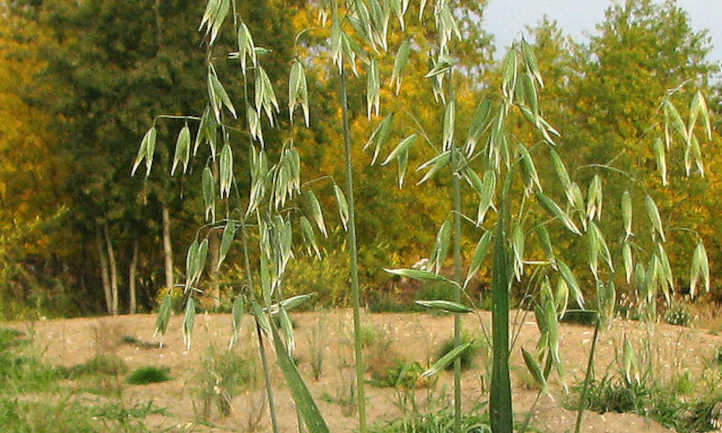
Care for wild oats is minimal, especially if you’re growing them as a cover crop. Remember, humans have been managing oats in many different locations and climates for a long time. Following a few simple guidelines will have you harvesting homegrown oats in no time!
Sun and Temperature
Oats prefer full sun but can tolerate partial sun with at least 6 hours of sunlight per day. Oats can be grown in most zones but will winterkill in Zone 7 or colder. Like wheat, there are many varieties of oats that have been adapted for specific climates, so be sure to pay attention to what variety you buy.
Oats flourish in cooler weather, especially during seed germination, but can tolerate warm weather, especially once the plants are more established. If the temperatures soar, make sure to provide some extra water. Most varieties of oats can handle light frosts but are usually killed by temperatures below 5°F.
Water and Humidity
Young oats love water and will be happiest with consistent watering. As they grow, wait until the soil starts to dry before watering. Try to water in the morning to protect the plants against the heat of the midday sun. Oats need around 1 inch of water a week in most climates, and it’s best to water at the base of the plant with something like a soaker hose or drip irrigation. Since oats are planted in a large grouping, focus on soaking the entire area of soil rather than specific plants. Spring or fall generally require less watering, especially if you live in an area with a lot of rain.
Soil
Oats thrive in average to moderately rich soil as long as it’s well-draining. Being grass, they prefer not to sit in damp soil for too long. Oats are very hardy and grow in even poor soils. They prefer acidic soils with a pH between 4.5–6.
Fertilizing
Fertilizing is often not necessary for oats. Because they can tolerate a variety of soils, wild oats don’t need a lot of extra help. Top-dressing with compost is a great way to provide some extra nutrients. If you choose to fertilize at all, choose a fertilizer like blood meal or feather meal that contains a high amount of nitrogen (the N in NPK) that will promote rapid plant growth. Phosphorus (P) and potassium (K) have not been shown to have much effect on oat growth. If you’re growing the crop as a winter cover, good news, no fertilization is needed because it becomes the fertilizer for next season’s plants!
Pruning/Training
Other than the final harvest, no pruning is needed for oats. Once the seed heads are cut for harvesting, the plant can continue to grow but won’t usually produce a second harvest of seeds. After the seeds are harvested, the plants can be cut down and buried or tilled into the soil, added to the compost pile, or hung to dry to make loose straw.
Propagation
Unlike some plants which can be propagated by cuttings, oats are only propagated by seed. Refer to the planting section above for how to plant oat seeds.
Harvesting and Storing

After watching your oats grow steadily throughout early spring and summer, you’re closing in on the best part, harvesting your oats! Harvesting oats can look a little complex at first glance, but it’s a relatively straightforward technique.
Harvesting
The most important part of harvesting is knowing when to harvest. Farmers harvest oats when they’ve reached around 35% moisture level, but an easy way for gardeners to tell the right time is by giving it the fingernail test. Press your fingernail into a kernel and it should easily dent. The greenest kernels should be transitioning to a cream color. Aim to harvest the plants after 24 to 48 hours of rain-free weather.
The easiest way to harvest at home is to use a sickle, scythe, or garden shears. Start the harvest by cutting down the stem of the oat plant but leave the seed heads intact. After this, you’ll want to allow the plants to dry. There are several techniques for this depending on your weather and available space. Many gardeners gather the stalks into bundles and stand them upright in a warm, sunny location. Another technique is to spread the stalks out in an area away from weather like a garage or a covered deck. You just want to keep the stalks dry and allow the seed heads to cure. Depending on your local conditions, this can take days to weeks.
Once the seed heads are dry, it’s time to thresh and winnow the oats. Threshing is the process of separating the seeds from the rest of the stalk. An easy way to do this is to set out a large tarp, take a bundle of stalks, and beat them against the tarp. If your arms tire, you can use something else like a plastic baseball bat to beat the stalks, which will loosen the oats. When the oats are separated from the stalk, it’s time to winnow.
Winnowing is the process of isolating the oats from the rest of the chaff. Place the oats and chaff into a large bowl or bucket. Choose a reasonably windy location or set up a fan to one side. Pour the contents of the bowl in front of the fan, landing in a separate container below. The wind will blow the lighter chaff away, leaving only the oats behind. The discarded stalks can be used as straw mulch or added to the compost bin.
Storing
Once the dry oats have been separated from the plant, they can be stored in an airtight container in a cool, dark area for up to 3 months. Cooked oats can be stored in the refrigerator for 4–6 days.
Troubleshooting
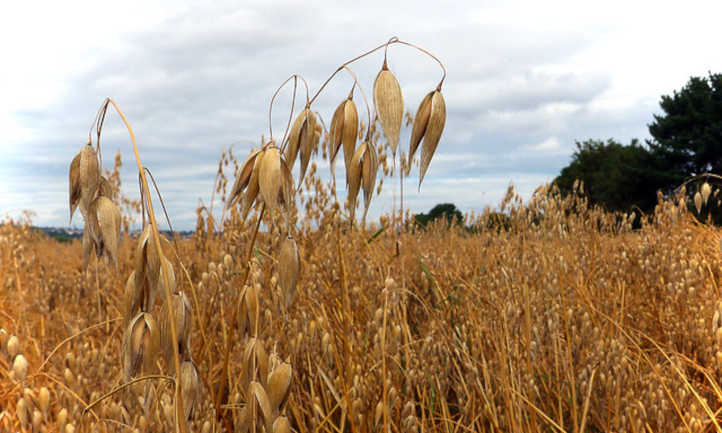
While oats are hardy and easy to grow, they can be affected by a few pests and diseases. Like most plants, prevention and proper growing conditions is the best defense.
Growing Problems
Because oats are so adaptable, there are not many growing issues outside of pests and diseases. The most common problem affecting home gardeners is watering. Too little water will stunt the growth of the plant (eventually leading to death) and too much water will lead to rot. The easiest way to make sure you’re watering the correct amount is to check the soil. Let the soil dry to about an inch deep before watering more.
Pests
Pests like aphids and armyworms attack the leaves of the plant. Hitting the plants with jets of water will knock the pests off and spraying neem oil will help control the population levels. Stinkbugs and wireworms like to attack young plants. Crop rotation and removal of weeds and garden debris will help keep the numbers of stinkbugs and wireworms low.
Diseases
The majority of oat diseases are fungal and usually caused by overly damp conditions. Anthracnose, crown rust, powdery mildew, loose smut, and scab can be prevented by planting in a warm, dry location, and practicing crop rotation. Barley yellow dwarf is a virus transmitted by aphids, so control of the aphid population is the best defense.
Frequently Asked Questions

Q: How long does it take for oats to grow?
A: Roughly 6 months from seed to harvest.
Q: Are oats easy to grow?
A: Yes! Oats have been adapted to most climates and grow easily.
Q: What climate is needed to grow oats?
A: Oats do best in temperate climates, but varieties have been adapted to many areas.

